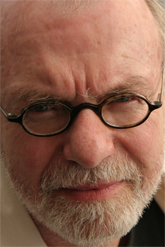One of the leading figures in the interdisciplinary field known as visual culture, W. J. T. Mitchell, the Gaylord Donnelley Distinguished Service Professor at the University of Chicago, studies the interplay of vision and language in art, literature, and media, addressing both general problems in the theory of representation and specific issues in cultural politics and political culture.
Professor Mitchell has appointments in the Department of English and Art History, and has been the editor of the highly influential interdisciplinary humanities journal, Critical Inquiry, since 1978. Beginning his academic career as a literary critic, Professor Mitchell undertook from the start a consideration of literary texts alongside visual and other imagery, as reflected in his first book, Blake's Composite Art (Princeton University Press, 1977).
In Iconology: Image, Text, Ideology (University of Chicago Press, 1986), Professor Mitchell continues his analysis of verbal and pictorial forms of representation by conducting an intricate study of four theoretical episodes, each of which illustrates varying ideological stakes at work in the differences argued for between image and text, picture and word, eye and ear, space and time, convention and nature. Picture Theory: Essays on Verbal and Visual Representation (University of Chicago Press, 1994) extends the theoretical debates and episodes of the first book into case studies that speak to the late twentieth century fascination with visuality and the power of the image. Ranging from discussion of the philosophical complexities raised by metaphysics through the work of Magritte and Wittgenstein, to the genre of the photographic essay, to the films of Spike Lee and Oliver Stone, the book offers a rich account of the interplay between the visible and the readable across culture. Mitchell continues the development of his groundbreaking picture theory in What Do Pictures Want? The Lives and Loves of Images (University of Chicago Press, 2004) with an examination of a range of images, from the iconoclastic terror of 9/11 to the image of Dolly the Sheep, not as inert objects or signs awaiting interpretation, but as animated beings that make demands of us. This trilogy firmly established Professor Mitchell as one of the leading critics of visual culture.
Mitchell has also reshaped the field of landscape studies by considering landscape not simply as an object to be seen or a text to be read, but as an instrument of cultural force, a central tool in the creation of national and social identities. His current work speaks to both his role as a theorist of images across the media, in a volume edited (with Mark Hansen), Critical Terms for Media Studies, due out in March 2010, and to his role as a cultural critic in another book in progress, Cloning Terror: The War of Images, September 11 to Abu Ghraib.
Professor Mitchell has received fellowships from the Guggenheim Foundation, the National Endowment for the Humanities, and the American Philosophical Society. Among other honors, he was awarded the Modern Language Association's 2006 James Russell Lowell Prize in Language and Literature for What Do Pictures Want?


